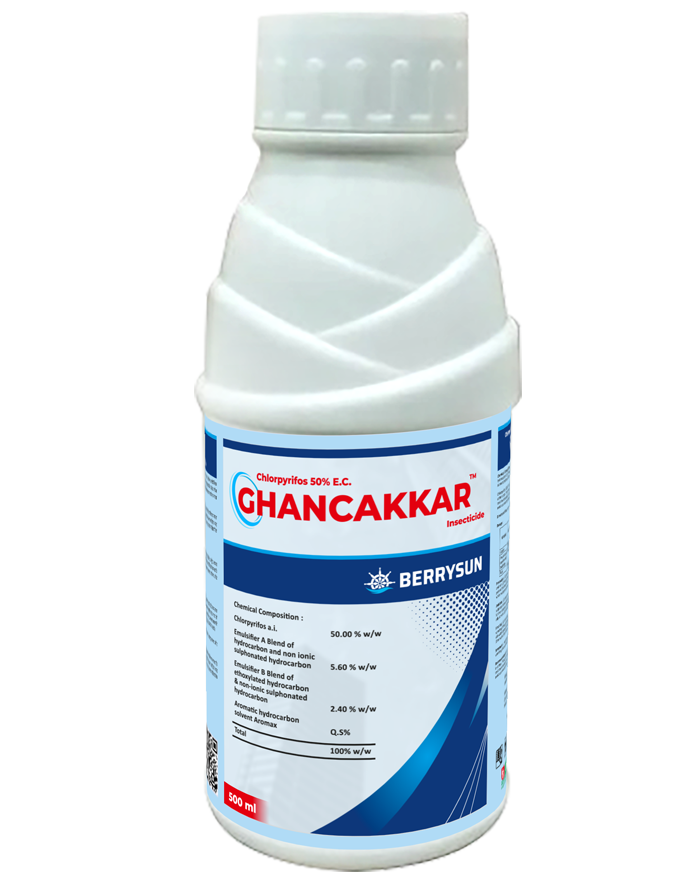| Crop(s) | Common Name of Pest | Dosage/HA | AI (gm) | Formulation (gm) | Dilution in Water (liter) | Waiting Period Between Last Spray to Harvest (days) | Re-entry After Each Application (In Hours) |
|---|---|---|---|---|---|---|---|
| Cotton | Boll worms | 500-600 | 1000-1200 | 500-1000 | 30 | ||
| Pre and post construction buildings | Termite | 0.25% | 0.50% | 1 Lit formulation in 99 Lit | |||
| Rice | Stem borer and Leaf roller | 375-400 | 750-800 | 500-1000 | 15 |
Time of Application: -
Precautions
- Keep away from foodstuffs, empty foodstuff containers, and animal’s food.
- Avoid contact with mouth, eyes, and skin.
- Avoid inhalation of the spray mist. Spray in the direction of wind.
- Wash thoroughly the contaminated clothes and parts of the body after spraying.
- Do not smoke, drink, eat, and chew anything while spraying.
- Wear full protective clothing while mixing and spraying.
Symptoms of Poisoning
Headache, giddiness, vertigo, nausea, vomiting, blurred vision, diarrhea, convulsions, sweating, excessive lacrimation, and salivation may occur.
First Aid
- If swallowed, induce vomiting by tickling the back of the throat. Repeat it until the vomitus is clear. Do not induce vomiting if the patient is unconscious.
- If clothing and skin are contaminated, remove the clothes and wash the contaminated skin with copious amount of soap and water.
- If eyes are contaminated, flush with plenty of saline/clean water for about 10 to 15 minutes.
- If inhaled, remove the patient to fresh air.
Phytotoxicity
Antidote
- Atropinize the patient immediately and maintain full atropinization by repeated doses of 2 to 4 mg of atropine sulphate intravenously at 5 to 10 minutes interval. As much as 25 to 50 mg of atropine may be required in a day. The need for further atropine administration is guided by the continuance of symptoms. Extent of salivation is a useful criterion for dose adjustment.
- Dissolve 1-2 gm of 2 PAM in 10 ml distilled water and inject intravenously very slowly for 10-15 minutes.
Disposal of Used Container
The empty containers should never be reused and should be destroyed and buried in a safe place. Dispose off packages or surplus material and washings in a safe manner so as to prevent environmental and water pollution.
Storage Conditions
The package containing the formulated grade insecticides should be stored in original containers in a separate room or almirah under lock and key depending on the quantity of insecticides, away from the reach of children, foodstuffs, animal feeds and other articles, and kept in a cool and dry place. The premises for storage should be well built, well-lit, sufficient in dimension, and well-ventilated.
Chemical Composition
| S.No | Ingredient | Description | Weight |
|---|---|---|---|
| 1 | Chlorpyrifos a.i. | 50.00 % w/w | |
| 2 | Emulsifier A | Blend of hydrocarbon and non-ionic sulphonated hydrocarbon | 5.60 % w/w |
| 3 | Emulsifier B | Blend of ethoxylated hydrocarbon & non-ionic sulphonated hydrocarbon | 2.40 % w/w |
| 4 | Aromatic hydrocarbon solvent | Aromax | Q.S % |
| Total | 100 % w/w | ||
